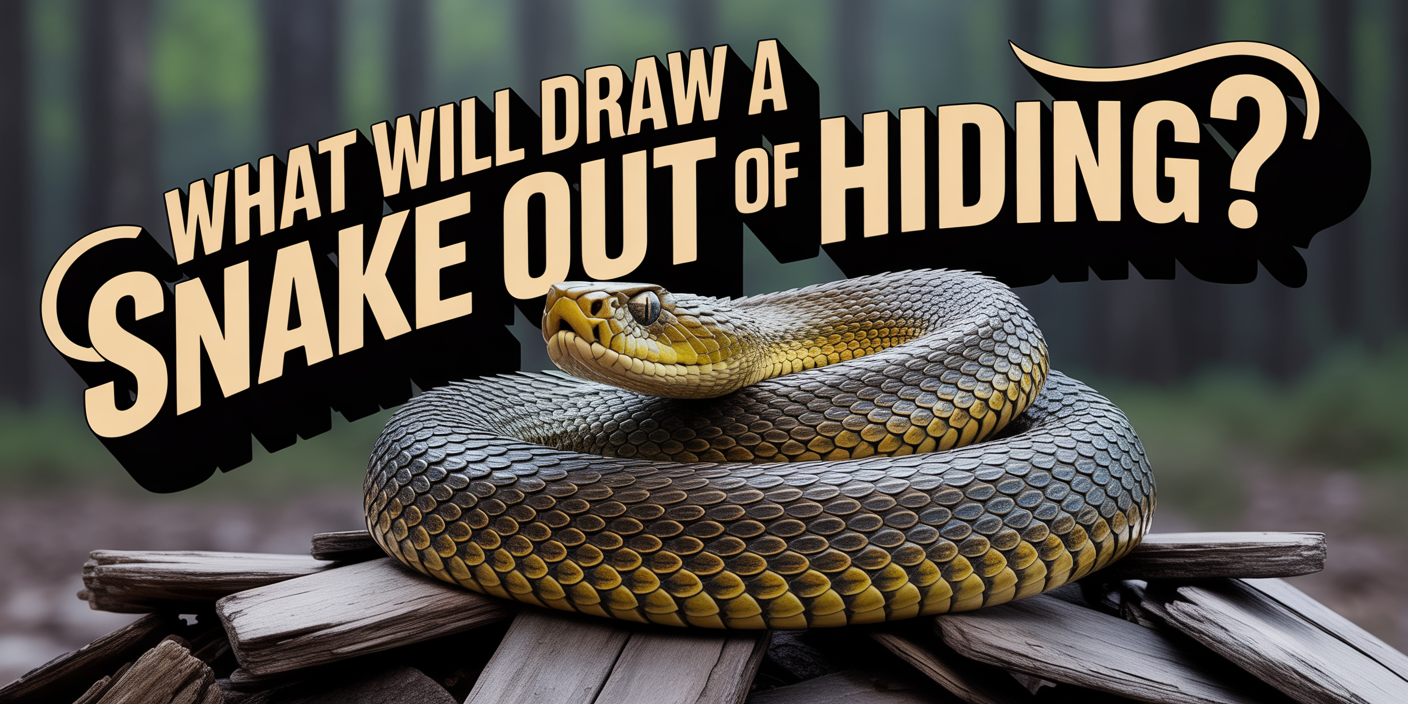“Warm surfaces, prey scent like rats, and sudden movement can lure a snake from its hiding place—but that doesn’t mean you should try it yourself. In the Treasure Coast, safely drawing out a snake is a job that must be handled by trained professionals like AAAC Wildlife Removal.”
Snakes are masters of staying hidden, especially in the warm, wildlife-rich areas of Florida’s Treasure Coast. Whether they’re curled up in your garage, tucked under your deck, or slithering through garden brush, they tend to go unnoticed until someone accidentally stumbles across them. That’s when the real question hits: what will actually draw a snake out of hiding? Homeowners might be tempted to poke around or try baiting them—but that can quickly turn into a dangerous mistake.
In a region like Port St. Lucie, Vero Beach, or Fort Pierce, where both harmless and venomous species are common, it’s critical to understand snake behavior before taking action. Drawing a snake out is less about tricks and more about knowing what attracts them in the first place—things like food, warmth, and shelter. If you’re dealing with a snake infestation, calling local pros like AAAC Wildlife Removal of Treasure Coast for snake removal is the safest and most effective way to handle a hidden serpent situation. This guide breaks it all down and explains why professional help is key to resolving your snake problem.
Learn more: When you see one snake, are there more?
Why Do Snakes Hide in the First Place?
Snakes aren’t trying to scare you—they’re just following their instincts. In Florida’s Treasure Coast, snakes often seek out quiet, shaded, or enclosed spaces to rest, regulate their body temperature, or hunt for prey. These spaces could be anything from a crawl space under your house to a stack of firewood or a rock pile near your fence line.
Local species like black racers, corn snakes, and even venomous cottonmouths rely on these hiding spots to stay safe and undisturbed. Because they don’t generate body heat on their own, snakes use their environment to maintain the right temperature, especially during cooler mornings or hot afternoons. That’s why your shaded porch or sunny walkway can easily become an unintended snake sanctuary.
What Attracts a Snake to Come Out?
1. Temperature and Sunlight
Snakes are ectothermic, meaning they depend on external heat to regulate their body temperature. In places like Treasure Coast, FL, snakes often leave hiding spots during the morning or evening to bask on warm pavement, stones, or patios. This behavior helps them stay active, digest food, and move more efficiently. It’s one of the most common reasons you might suddenly see a snake out in the open.
2. Scent of Prey
The scent of small animals like mice, frogs, lizards, or even chipmunks can lure a snake from its hiding spot. Snakes use their tongue to “taste” scent trails, and once they detect a nearby meal, they may slither out to investigate. If your home or yard has a pest problem, it’s practically sending an invitation. That’s why a snake showing up is often a symptom—not the root issue.
3. Vibrations or Movement
Snakes are extremely sensitive to ground vibrations and can detect the movement of nearby prey or predators. Sometimes, walking near their hiding spot or moving objects like lawn furniture or tools can flush them out. This is why many homeowners accidentally come face-to-face with a snake while mowing the lawn or sweeping a patio.
4. Lack of Shelter or Disturbance
When their hiding spot becomes exposed—either by landscaping, weather, or human activity—snakes may be forced to move. Removing yard debris, trimming overgrown bushes, or disturbing woodpiles can push a snake into the open. In these moments, they’re not trying to interact with humans, just looking for a safer place to hide.
5. Mating Season Behavior
During breeding season, which in Florida typically runs from spring through early summer, snakes become more active. Males especially will roam in search of females, leading them to leave their usual hiding places and cover more ground. This spike in movement increases sightings around homes, gardens, and even garages. It’s one reason why springtime brings a surge in local snake removal calls.
Should You Try to Draw a Snake Out Yourself?
Trying to lure a snake out might seem like a smart shortcut—but it usually leads to trouble. Unless you’re trained in identifying Florida’s native species, there’s a real risk of mistaking a venomous snake like a cottonmouth for something harmless. Even non-venomous snakes will bite if they feel cornered or threatened, and that can still result in infection, injury, or a terrifying experience.
In Florida, it’s also important to consider the legal side. Some snake species are protected, and mishandling them—even with good intentions—can land you in hot water. More importantly, disturbing a snake’s hiding place can backfire, causing it to retreat deeper into your property or find a more dangerous spot like your attic or crawl space. That’s why calling in professionals like AAAC Wildlife Removal of Treasure Coast is the safest and smartest move.
What AAAC Wildlife Removal of Treasure Coast Does Instead
1. Property Inspection and Snake Detection
We start by inspecting your entire property to identify where the snake is hiding and why it’s there in the first place. If you’ve recently found a snake or spotted a rat in your garage, attic, or garden, chances are high that more could be nearby. Our local experts are trained to spot common snake hideouts around Treasure Coast homes—like under decks, in crawl spaces, behind appliances, or near pool equipment. We also look for shed skins, droppings, and other activity signs that suggest a snake may still be present.
2. Species Identification
Not every snake in your house needs the same removal strategy. Our technicians are trained to identify both harmless species and dangerous ones that require immediate attention. Whether it’s a non-venomous corn snake or a venomous moccasin, knowing exactly what we’re dealing with is critical. Every snake must be handled with caution and according to Florida’s wildlife laws to ensure legal and humane treatment.
3. Humane Snake Removal
Once the snake is located and identified, we use humane, professional tools and methods to safely remove the snake without harm. In some cases, we may set a live snake trap in areas of high activity if the snake cannot be reached directly. Tools like tongs, secure enclosures, and one-way exits help us capture snakes discreetly, especially when the snake is hiding in walls, basements, or under flooring.
4. Entry Point Sealing and Habitat Modification
After we remove the snake, our next step is to make sure others can’t get in. This means sealing off entry points like vents, cracks, and gaps, especially around the base of your home or sheds. We’ll also recommend habitat changes—like clearing brush piles or rodent control—because if a rat problem exists, snakes will keep coming back. Modifying these outdoor conditions is essential when a snake may return due to ongoing food sources or shelter opportunities.
5. Follow-Up and Prevention Support
Our job doesn’t end after one visit. We offer follow-up support and long-term prevention plans to make sure you’re fully protected. If a snake must be removed once, there’s always the chance others may return if conditions haven’t changed. Our team gives clear, actionable tips that address the specific layout and environment of your property so future encounters are avoided altogether.
How to Tell If a Snake Is Still Hiding Nearby
Sometimes the snake you saw slither under the shed never actually left. One of the clearest signs a snake is still hanging around is the presence of shed skins—these look like dry, translucent outlines of the snake’s body and are often found near walls, foundations, or in crawl spaces. Another giveaway is snake droppings, which may contain traces of fur, bones, or scales from prey.
You might also notice your pets acting strangely, like barking or pawing at a specific spot. If rodents suddenly go quiet or disappear, that could also mean a predator has moved in. Snakes are sneaky and silent, so spotting them requires a sharp eye and some professional insight—which is why an expert inspection from AAAC Wildlife Removal of Treasure Coast can make all the difference.
Pro Tips Will Prevent To Snakes from Returning
1. Eliminate Food Sources
Rodents, frogs, lizards, and even insects are a snake’s dinner menu. If these pests are present in your yard or home, snakes won’t be far behind. Use sealed trash bins, don’t leave pet food outdoors, and consider professional pest control if you’re seeing regular rodent activity.
2. Declutter Your Yard
Snakes love clutter because it gives them cover. Tall grass, woodpiles, leaf piles, and overgrown bushes all serve as cozy hiding spots. Keep your lawn mowed, trim vegetation regularly, and move wood or rock piles far from your home’s foundation.
3. Seal Entry Points
Small gaps in siding, vents, doorways, or foundation cracks are open invitations for snakes. Inspect your home thoroughly and seal any holes using steel mesh, weather stripping, or caulking. Don’t forget areas like crawl spaces, garages, and sheds.
4. Remove Standing Water
Snakes are drawn to water just like many of their prey animals. Birdbaths, clogged gutters, and leaky garden hoses can create mini water sources that attract reptiles. Fix drainage issues and keep water sources under control, especially during Florida’s rainy season.
5. Add Snake Deterrents
There are a variety of natural and commercial repellents that can help discourage snakes. Some homeowners install vibrating devices, while others use strong-smelling deterrents like sulfur or clove oil granules. These can be effective when combined with the preventive strategies above—but the most reliable approach still involves regular inspections and expert help from AAAC Wildlife Removal of Treasure Coast.
Call AAAC Wildlife Removal of Treasure Coast
If you suspect a snake is hiding somewhere on your property, don’t take chances—call the local experts who handle it all. AAAC Wildlife Removal of Treasure Coast offers fast, professional snake removal services across Port St. Lucie, Fort Pierce, Vero Beach, Stuart, and surrounding areas. We’re fully licensed, insured, and trained to deal with Florida’s diverse snake population—safely, humanely, and legally.
From thorough inspections and expert species ID to safe removal and long-term prevention, we’ve got your back every step of the way. Don’t wait for a surprise slither—get in touch today and reclaim your peace of mind. One call to AAAC Wildlife Removal, and your snake problem is solved the right way.




